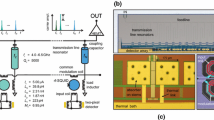Abstract
Microwave SQUID multiplexing has become a key technology for reading out large arrays of X-ray and gamma-ray microcalorimeters with mux factors of 100 or more. The desire for fast X-ray pulses that accommodate photon counting rates of hundreds or thousands of counts per second per sensor drives system design toward high sensor current slew rate. Typically, readout of high current slew rate events is accomplished by increasing the sampling rate, such that rates of order 1 MHz may be necessary for some experiments. In our microwave multiplexed readout scheme, the effective sampling rate is set by the frequency of the flux-ramp modulation (\(f_\mathrm{r}\)) used to linearize the SQUID response. The maximum current slew rate between samples is then nominally \(\varPhi _0 f_\mathrm{r}/2M_\mathrm{in}\) (where \(M_\mathrm{in}\) is the input coupling) because it is generally not possible to distinguish phase shifts of \(> \pi \) from negative phase shifts of \(< -\pi \). However, during a pulse, we know which direction the current ought to be slewing, and this makes it possible to reconstruct a pulse where the magnitude of the phase shift between samples is \(>\pi \). We describe a practical algorithm to identify and reconstruct pulses that exceed this nominal slew rate limit on the rising edge. Using pulses produced by X-ray transition-edge sensors, we find that the pulse reconstruction has a negligible impact on energy resolution compared to arrival time effects induced by under-sampling the rising edge. This technique can increase the effective slew rate limit by more than a factor of two, thereby either reducing the resonator bandwidth required or extending the energy range of measurable photons. The extra margin could also be used to improve crosstalk or to decrease readout noise.


Similar content being viewed by others
References
J.A.B. Mates, D.T. Becker, D.A. Bennett, B.J. Dober, J.D. Gard, J.P. Hays-Wehle, J.W. Fowler, G.C. Hilton, C.D. Reintsema, D.R. Schmidt, D.S. Swetz, L.R. Vale, J.N. Ullom, Appl. Phys. Lett. 111, 062601 (2017). https://doi.org/10.1063/1.4986222
D.A. Bennett, J.A.B. Mates, S.R. Bandler, D.T. Becker, J.W. Fowler, J.D. Gard, G.C. Hilton, K.D. Irwin, K.M. Morgan, C.D. Reintsema, K. Sakai, D.R. Schmidt, S.J. Smith, D.S. Swetz, J.N. Ullom, L.R. Vale, A.L. Wessels, J. Astron. Telesc. Instr. Syst. 5(2), 021007 (2019). https://doi.org/10.1117/1.JATIS.5.2.021007
J.A.B. Mates, K.D. Irwin, L.R. Vale, G.C. Hilton, J. Gao, K.W. Lehnert, J. Low Temp. Phys. 167, 707 (2012). https://doi.org/10.1007/s10909-012-0518-6
J.A.B. Mates, Ph.D. thesis, The microwave SQUID multiplxer (2011)
D. Li, B.K. Alpert, D.T. Becker et al., J. Low Temp. Phys. 193, 1287 (2018). https://doi.org/10.1007/s10909-018-2053-6
S.R. Bandler, J.A. Chervenak, A.M. Datesman, A.M. Devasia, M.J. DiPirro, K. Sakai, S.J. Smith, T.R. Stevenson, W. Yoon, D.A. Bennett, J.A.B. Mates, D.S. Swetz, J.N. Ullom, K.D. Irwin, M.E. Eckart, E. Figueroa-Feliciano, D. McCammon, K.K. Ryu, J.R. Olson, Ben Zeiger, J. Astron. Telesc. Instr. Syst. 5(2), 021017 (2019). https://doi.org/10.1117/1.JATIS.5.2.021017
K.D. Irwin, H.M. Cho, W.B. Doriese, J.W. Fowler, G.C. Hilton, M.D. Niemack, C.D. Reintsema, D.R. Schmidt, J.N. Ullom, L.R. Vale, J. Low Temp. Phys. 167, 588 (2012). https://doi.org/10.1007/s10909-012-0586-7
J.W. Fowler, B.K. Alpert, W.B. Doriese, Y.-I. Joe, G.C. O’Neil, D.S. Swetz, J. Low Temp. Phys. 184, 374 (2016). https://doi.org/10.1007/s10909-015-1380-0
Acknowledgements
This work was supported by the U.S. Department of Energy, Office of Science, Office of Basic Energy Sciences, the National Institute of Standards and Technology (NIST) Innovations in Measurement Science (IMS) program, and by NASA SAT “Microwave SQUID readout technology to enable Lynx and other future Great Observatories,” NASA Order NNG16PT18I.
Author information
Authors and Affiliations
Corresponding author
Additional information
Publisher's Note
Springer Nature remains neutral with regard to jurisdictional claims in published maps and institutional affiliations.
Rights and permissions
About this article
Cite this article
Morgan, K.M., Becker, D.T., Bennett, D.A. et al. Expanding the Capability of Microwave Multiplexed Readout for Fast Signals in Microcalorimeters. J Low Temp Phys 199, 164–170 (2020). https://doi.org/10.1007/s10909-019-02250-2
Received:
Accepted:
Published:
Issue Date:
DOI: https://doi.org/10.1007/s10909-019-02250-2




